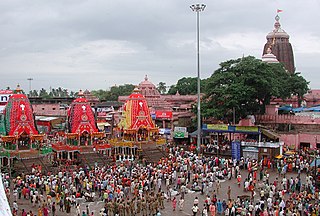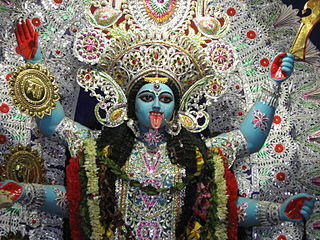
Chamunda, also known as Chamundeshwari, Chamundi or Charchika, is a fearsome form of Chandi, the Hindu Divine Mother Durga or Shakthi and is one of the seven Matrikas.

Ratha Yatra is a Hindu festival associated with Lord Jagannath held at Shri Khetra Puri Dham in the state of Odisha, India. It is the oldest Ratha Yatra, whose descriptions can be found in Brahma Purana, Padma Purana, and Skanda Purana and Kapila Samhita. Rath Yatra or Jatra is the celebration of the Lord Jagannath, who is believed to be the Lord of Universe's journey towards his aunt's house.

Nabarangpur is a town and a municipality in Nabarangapur district in the Indian state of Odisha. It is the headquarters of Nabarangpur district.

The Thracian religion refers to the mythology, ritual practices and beliefs of the Thracians, a collection of closely related ancient Indo-European peoples who inhabited eastern and southeastern Europe and northwestern Anatolia throughout antiquity and who included the Thracians proper, the Getae, the Dacians, and the Bithynians. The Thracians themselves did not leave an extensive written corpus of their mythology and rituals, but information about their beliefs is nevertheless available through epigraphic and iconographic sources, as well as through ancient Greek writings.

Santoshi Mata or Santoshi Maa is a Goddess in the Hindu folklore. She is venerated as "the Mother of Satisfaction", the meaning of her name. Santoshi Mata is particularly worshipped by women of North India. A vrata called the Santoshi Maa vrata performed by people on 16 consecutive Fridays wins the Goddess' favour.

Khonds are a tribal community in India. Traditionally hunter-gatherers, they are divided into the hill-dwelling Khonds and plain-dwelling Khonds for census purposes; all the Khonds identify by their clan and usually hold large tracts of fertile land but still practice hunting, gathering and slash-and-burn agriculture in the forests as a symbol of their connection to and ownership of the forest. Khonds speak the Kui and Kuvi languages and write them in Odia script.

Maa Tarini is one of the embodiments of Shakti and is one of the chief presiding Goddesses in Odia culture. Her chief shrine is in Ghatgaon, Keonjhar District, Odisha, India.

Jai Santoshi Maa is a 1975 Indian Hindi-language devotional film directed by Vijay Sharma and written R. Priyadarshi. Santoshī Mā is the goddess of satisfaction. Usha Mangeshkar, sang the devotional songs for the film along with Mahendra Kapoor and the famous poet Kavi Pradeep, who wrote the lyrics of the songs. Made on a low-budget, the film became one of the top blockbusters of all time.

Umerkote, also known as Umarkot and Amarkot, is a town of Nabarangpur district, Odisha, in eastern India. Umerkote is an urban area and the name of a Municipality declared on 3 March 2014 and a Subdivision declared by State Cabinet on 3 November 2015. The town is a prominent business place of the Nabarangpur District.

The Maa Sarala Temple is a Hindu temple in the district of Jagatsinghpur, Odisha, India. It is one of the eight most famous Shakta shrines of Odisha.
The Lakshmi (Laxmi) Purana is a purana written in the 15th century by Balarama Dasa, a major poet of Odia literature who is often considered the senior most poet in the Age of Panchasakha. On 18 April 2019, Manabasa Gurubara has been added to the ‘National List of Intangible Cultural Heritage (ICH) of India’.

Nuakhai or Navakhai or is an agricultural festival mainly observed by people of Western Odisha and Southern Chhattisgarh in India. Nuakhai is observed to welcome the new rice of the season. According to the calendar it is observed on panchami tithi of the lunar fortnight of the month of Bhadrapada or Bhadraba (August–September), the day after the Ganesh Chaturthi festival. This is the most important social festival of Western Odisha and adjoining areas of Simdega in Jharkhand, where the culture of Western Odisha is much predominant because there are so many things learn about agriculture with Hunan behavior also, nuakhai is very big festival and a unique festival also that's why every Indian knowing to Nuakhai History if you love any food then.

Bhunjias, are an ethnic group found in India mainly reside in Sunabeda plateau in Odisha and Chhattisgarh. They are mostly found in Nuapada district, which is roughly between 22° 55′ N and 21° 30′ N latitude and 82° 35′ E longitude. It was a part of Khariar Zamindari, which formed the eastern and the southeastern region of Raipur district of Chhattisgarh division in Central Province till 1 April 1936, when it was transferred to Odisha on its creation. It is now in Komna block of Nuapada district in Orissa. In Chhattisgarh they are found in Raipur district.

Maa Mangala Temple is a Hindu temple located at Kakatpur of Odisha, on the eastern coast of India. This is a 15th-century temple and a symbol of the ancient heritage of Kalinga. The holy Bay of Bengal is situated in the eastern side of the temple, the temple is situated at the eastern bank holy river "The Prachi", the Holy river Prachi was named as Saraswati before. The temple is reachable by the roads from Cuttack, Bhubaneswar, Puri, Jagatsinghpur and Paradeep which are approximately 69 km, 60 km, 55 km, 38 km and 83 km respectively and is well connected by roads. The nearest railway station is Bhubaneswar and the nearest airport is also Bhubaneswar."Maa Mangala" is a Hindu goddess who is one of the manifestations of "SHAKTI". The worship of the goddess is a part of the culture of Odisha. Before she was worshiped as goddess "Tara" by Buddhist monks. But when the deity was established at kakatpur, she was worshiping as the manifestations of Goddess "Durga". She is worshiping in the hymn of the goddess "Vanadurga". The curving style of the deity Mangala is typical Odia style, having khilana & prabha back to her sitting place. Also the style of temple is "Utkaliya Peedha Vimana Style".

Bhumij are a Munda ethnic group of India. They primarily live in the Indian states of West Bengal, Odisha, and Jharkhand, mostly in the old Singhbhum district, and can also be found in Bangladesh. They speaks Bhumij language. The Ol Onal script invented by Ol Guru Mahendra Nath Sardar, is used to write Bhumij language in some parts of West Bengal, Jharkhand, Odisha and Assam.

Kali Puja, also known as Shyama Puja or Mahanisha Puja, is a festival, originating from the Indian subcontinent, dedicated to the Hindu goddess Kali, celebrated on the new moon day of the Hindu month Kartik especially in the regions of West Bengal, and in Mithila in Bihar, Odisha, Assam, Tripura, neighbouring country Bangladesh, and the town of Titwala in Maharashtra. Kali Puja is extremely popular in Nabadwip, Santipur, Tamluk, Barasat, Naihati, Barrackpore, Dakshineshwar and Tarapith in West Bengal, Guwahati in Assam, Udaipur in Tripura, Ganjam in Odisha, Dhaka and Chittagong in neighbouring country of Bangladesh. It coincides with the Lakshmi Puja day of Diwali. While the Hindu Bengalis, Odias, Assamese and Maithils worship the goddess Kali on this day, the rest of India and Nepal worships goddess Lakshmi on Diwali.

The Goddess Ugratara is the tutelary deity of Eastern Ganga dynasty kings of erstwhile Kalinga dynasty. Her ancient temple lies at Mulajharigarh village, Bhusandapur 65 kilometers from State capital Bhubaneswar, Odisha, India. The icon of Mother Tara is three-eyed and Chaturbhuja, holding potent weapons as sword, dagger, blue lotus and a drinking cup in her hands. She stands over a corpse on burning flames of funeral pyre. Serpent anklets and a serpent on crown are visible which clearly dates back to the time of the 11th-century Tantrik text Sadhanamala Tantra. When later kings of Gajapati dynasty revered goddess Kali or Shyamakaali she had less importance and her worship received less attention. But many people belonging to Vasishtha Gotra revere her as Ishta devi. She is one among ten Mahavidya in Hindu Tantrik theology. She is very popular as Ugratara due to her fierce aspect, but benevolent to the adorers as Ekajata/Neela-Saraswati. Nearby railway station is Bhushandapur in Khordha district which is accessible from Bhubaneswar and Balugaon by local passenger trains. The main festivals here are Chaitra parba, Raja Parba, Sharadiya Durga Puja. She is worshipped in tantrik way and offered all tantrik fivefold paraphrenalias.

Chandahandi is a town and Block in Nabarangpur District in Odisha State in India.
The Aphrodisia festival was an annual festival held in Ancient Greece in honor of the goddess of love and beauty, Aphrodite. It took place in several Ancient Greek towns, but was especially important in Attica and on the island of Cyprus, where Aphrodite was celebrated with a magnificent celebration. The festival occurred during the month of Hekatombaion, which modern scholars recognize as starting from the third week in July to the third week of August on the Gregorian calendar. Aphrodite was worshipped in most towns of Cyprus, as well as in Cythera, Sparta, Thebes, Delos, and Elis, and her most ancient temple was at Paphos. Textual sources explicitly mention Aphrodisia festivals in Corinth and in Athens, where the many prostitutes that resided in the city celebrated the festival as a means of worshipping their patron goddess. Though no textual sources expressly mention an Aphrodisia festival in Cythera, Thebes, or Elis, it likely occurred since textual and iconographical sources indicate that Aphrodite Pandemos had a cult following in these areas. The Aphrodisia festival was one of the most important ceremonies in Delos, though we do not know much about the details of the celebration. The inscriptions merely indicate that the festival required the purchase of ropes, torches and wood, which were customary expenses of all Delian festivals.

Mānabasā Gurubāra is a festival celebrated by Odia Hindus in the Indian state of Odisha and Andhra Pradesh. It is also celebrated by Odias living in Andhra Pradesh, Chhattisgarh, South Jharkhand and South West Bengal. Even this festival is celebrated by Telugu's living in Andhra Pradesh/mostly in North Andhra Pradesh .In this festival Goddess Mahalaxmi is the presiding deity. It is believed by the people that the goddess herself comes to every household and removes pain and sorrow. It is held on every Thursday in the month of Margasira.















